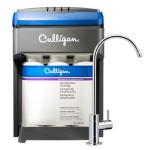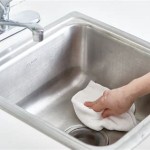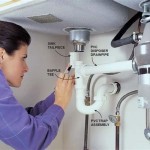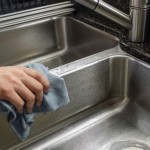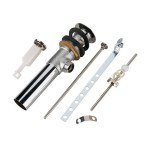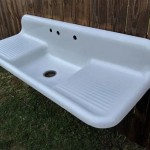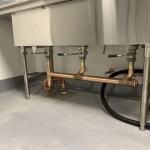```html
Unclogging a Garbage Disposal Sink in the Kitchen
A clogged garbage disposal sink is a common kitchen plumbing issue that can disrupt daily routines. Understanding the causes and employing effective unclogging techniques can often resolve the problem without the need for professional assistance. This article provides a comprehensive guide to diagnosing and rectifying garbage disposal sink clogs.
Identifying the Source of the Clog
The first step in addressing a clogged garbage disposal is accurately identifying the source of the blockage. Several factors can contribute to clogs, and determining the specific cause helps in selecting the most appropriate unclogging method. Common culprits include food scraps, grease, and foreign objects.
Food Scraps: Certain food items are notorious for causing garbage disposal clogs. These include fibrous vegetables like celery and asparagus, which tend to wrap around the disposal blades and impede their function. Starchy foods such as rice and pasta absorb water and expand, forming a sticky mass that can block the drainpipe. Eggshells, often mistakenly believed to sharpen the blades, can actually accumulate and contribute to clogs. Coffee grounds, while seemingly harmless, can clump together and create a dense blockage over time. Bones, fruit pits, and other hard materials should never be placed in the disposal, as they can damage the blades and cause severe clogs.
Grease: Pouring grease down the drain is a primary cause of garbage disposal clogs. As the grease cools, it solidifies and adheres to the inside of the drainpipe. This creates a sticky surface that traps food particles and other debris, gradually narrowing the pipe and eventually leading to a complete blockage. Even small amounts of grease, accumulated over time, can contribute to significant clogs.
Foreign Objects: Accidental introduction of non-food items into the garbage disposal is another frequent cause of clogs. Silverware, bottle caps, and small pieces of plastic can easily fall into the disposal unnoticed. These objects can jam the blades, obstruct the drain, and potentially damage the disposal unit. Before attempting to unclog the disposal, visually inspect the chamber for any visible foreign objects.
Drainpipe Blockage: Sometimes the clog is not directly within the garbage disposal unit itself, but rather in the drainpipe downstream. Food debris, grease, and other materials can accumulate in the pipe over time, creating a blockage that affects the entire sink drainage system. In these cases, unclogging the drainpipe may be necessary to resolve the issue.
Safety Precautions Before Unclogging
Before attempting to unclog a garbage disposal, it is crucial to prioritize safety. Following these precautions minimizes the risk of injury and prevents damage to the disposal unit.
Disconnect the Power: The most important safety precaution is to disconnect the power to the garbage disposal. Locate the circuit breaker that controls the disposal and switch it off. This prevents accidental activation of the disposal while your hands are inside, which could result in serious injury. Some disposals have an on/off switch located near the unit itself; ensure that this switch is also in the off position. Double-checking the power disconnection is essential before proceeding.
Avoid Using Your Hands: Never reach directly into the garbage disposal chamber with your bare hands. The blades, even when the disposal is off, can pose a risk. Utilize tools such as tongs, pliers, or a long-handled utensil to remove any visible debris or foreign objects. If you cannot see what is causing the clog, do not blindly reach into the disposal. Consider using a flashlight to illuminate the chamber and improve visibility.
Wear Protective Gear: Wearing gloves is recommended to protect your hands from bacteria and sharp objects. Safety glasses can also provide additional protection from splashing water or debris that may dislodge during the unclogging process. Taking these simple precautions can significantly reduce the risk of injury or infection.
Methods for Unclogging a Garbage Disposal
Several methods can be employed to unclog a garbage disposal, ranging from simple techniques to more involved procedures. The choice of method depends on the severity and nature of the clog.
Using Tongs or Pliers: If a visible foreign object is causing the clog, use tongs or pliers to carefully remove it. Ensure the power is disconnected before reaching into the disposal. Visually inspect the chamber thoroughly to ensure all objects have been removed. After removing the object, run cold water into the disposal and turn it on briefly to test if the clog has been resolved.
The Plunger Method: A plunger can be effective in dislodging clogs caused by food debris or grease. First, ensure that the sink basin contains enough water to cover the cup of the plunger. Cover the other sink drain opening with a wet cloth or stopper to create a tight seal. Place the plunger cup over the garbage disposal opening, ensuring a good seal. Push and pull the plunger forcefully several times. Remove the plunger and check if the water drains freely. Repeat the process if necessary. If the plunger method proves ineffective, try a different approach.
Baking Soda and Vinegar: A mixture of baking soda and vinegar can help dissolve grease and food particles that are causing the clog. Pour one cup of baking soda down the drain, followed by one cup of white vinegar. Allow the mixture to fizz and react for approximately 30 minutes. After 30 minutes, flush the drain with hot water for several minutes. This method is often effective for minor clogs caused by grease buildup. Repeat the process if the drain remains slow.
Hot Water Flush: Running hot water into the garbage disposal can help melt grease and dislodge some types of food debris. Turn on the hot water tap and let the water run into the disposal for several minutes. If the water begins to drain slowly, temporarily turn off the water and allow the water level to decrease. Then, resume running the hot water. This method is best used as a preventative measure to keep the disposal clean and prevent clogs from forming.
The Garbage Disposal Wrench: Many garbage disposals have a small opening on the bottom of the unit designed to accommodate a special wrench or an Allen wrench. This opening is used to manually turn the motor and dislodge any obstructions that may be jamming the blades. Disconnect the power to the disposal before using this method. Insert the wrench into the opening and turn it back and forth. This can help free up any stuck food debris or objects. After turning the wrench, remove it and check if the disposal blades are now moving freely. If they are, turn on the cold water and activate the disposal briefly to flush out any remaining debris.
Dish Soap and Hot Water: A combination of dish soap and hot water can help break down grease and loosen food particles. Pour a generous amount of dish soap down the drain, followed by a pot of boiling water. Allow the mixture to sit for several minutes, then flush the drain with hot water. The dish soap helps to emulsify the grease, while the hot water helps to dissolve it and flush it away.
Ice and Salt: The ice and salt method can help to sharpen the garbage disposal blades and dislodge debris. Pour a cup of ice cubes and a cup of coarse salt down the drain. Run cold water into the disposal and turn it on for a few seconds. The ice and salt help to scrub the inside of the disposal chamber and dislodge any accumulated debris. This method is more effective as a preventative maintenance measure rather than a solution for severe clogs.
Preventative Maintenance for Garbage Disposals
Regular maintenance is essential to prevent garbage disposal clogs and extend the lifespan of the unit. Implementing the following practices can significantly reduce the likelihood of future problems.
Avoid Problem Foods: Refrain from putting problematic food items down the garbage disposal. These include fibrous vegetables, starchy foods, grease, bones, fruit pits, and coffee grounds. Disposing of these items in the trash can help prevent clogs and damage to the disposal unit.
Run Cold Water: Always run cold water when operating the garbage disposal. Cold water helps to solidify grease and prevent it from coating the inside of the drainpipe. This allows the grease to be flushed away more easily, reducing the risk of clogs.
Regular Cleaning: Clean the garbage disposal regularly to remove accumulated food debris and prevent odors. A simple way to clean the disposal is to run cold water while dropping in citrus peels, such as lemon or orange peels. The citrus oils help to freshen the disposal and break down grease. Alternatively, a mixture of baking soda and vinegar can be used to clean and deodorize the disposal.
Flush with Hot Water: Periodically flushing the disposal with hot water can help melt away any grease buildup and keep the drainpipe clear. Run hot water into the disposal for several minutes, especially after using it to grind food scraps.
Grind Ice Cubes: Grinding ice cubes in the garbage disposal can help to sharpen the blades and dislodge any accumulated debris. The ice acts as a natural abrasive, cleaning the inside of the disposal chamber.
By following these preventative maintenance tips, homeowners can minimize the risk of garbage disposal clogs and ensure the efficient operation of their kitchen sink.
```
Clogged Kitchen Sink With Garbage Disposal How To Solve Quickly 3 Easy Fixes By Diynate

Most Effective Methods To Fix A Clogged Garbage Disposal

How To Fix A Clogged Kitchen Sink On Both Sides

4 Easy Ways To Unclog A Kitchen Sink With Garbage Disposal

How To Unclog A Garbage Disposal Diy Guide Affresh Appliance Care

How To Unclog A Garbage Disposal Diy Guide Affresh Appliance Care

How To Unclog A Garbage Disposal Step By Guide

How To Unclog A Garbage Disposal Rt Olson Plumbing

How To Unclog A Garbage Disposal In Your Kitchen

4 Ways To Unclog A Garbage Disposal Wikihow Life

